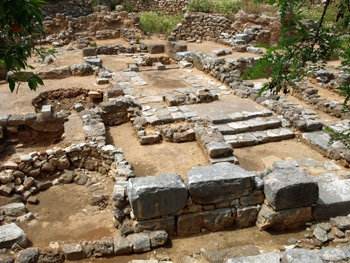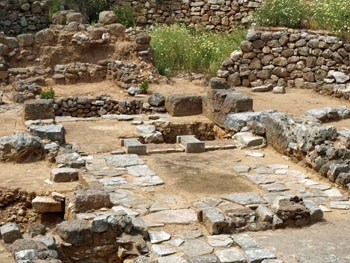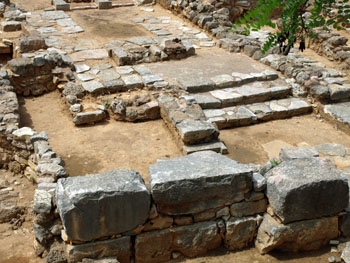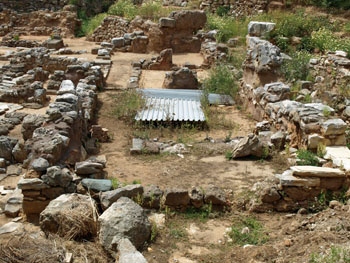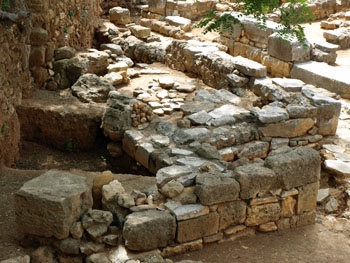Chania/Kydonia
In the last fifty years evidence has emerged for the presence of a major Minoan palace and town beneath the modern city of Chania. It has come to be known as Kydonia although its original name is not known. It has not been easy to excavate in Chania. Not only is the Minoan town buried beneath the modern city of Chania but above it there are various layers dating to the Roman, Byzantine, Venetian and Ottoman periods. Worse still, wells, pits and the foundations of other buildings dug during later times have disturbed the layers of Minoan and Mycenaean Kydonia.
However a number of small sites have been excavated, the most important of which are on the low hill called Kastelli behind the former Turkish mosque which is situated on the harbour front. This hill was occupied from the beginning of the Early Minoan period right through to the end of Late Minoan IIIC and beyond.
Excavators have found good quality architecture from the prepalatial period, especially from EM II and the EM III-MM IA periods. Protopalatial levels were largely destroyed when the neopalatial town was constructed but the excavators know that there was a Middle Minoan settlement in Kydonia from the finds of Kamares pottery, eggshell ware and stones with mason’s marks.
The largest site to be excavated so far is in Ayia Aikaterini Square and it has been excavated by a joint Greek-Swedish team, led by Tzedakis and Hallager, for over four decades. As the excavators dug, they began by uncovering layers from the LM III period. It was known that Kydonia continued to thrive as a town long after the destruction of Knossos and the arrival of Mycenaeans in Crete, so the presence of extensive LM III layers in Chania would not have come as a surprise.
Continuing down below the LM III levels, the excavations in the square revealed part of a neopalatial Minoan town. As was customary in the Minoan period, the houses were built in blocks and divided by narrow streets and squares. In Ayia Aikaterini Square four or possibly five houses from the neopalatial period have been uncovered.
For decades, however, the palace which archaeologists felt certain must lie beneath the modern town proved elusive. In a 2004 interview with Athena Review, Maria Andreadaki-Vlasaki outlined the evidence for the existence of a palace:
Firstly, a large archive of Linear A tablets, roundels, and nodules was discovered. It consisted of 97 pieces of clay tablets, 122 roundels, and 28 nodules, inscribed with Linear A syllabograms and ideograms. These listed agricultural products and censuses of people and animals. They were clear evidence for an advanced administrative system connected with the centralized economy of a powerful society. Chania has the second largest number of Linear A tablets of any Minoan centre and the largest number of roundels.
Secondly, many features prominent in the architecture of the other palaces have been noted at Chania. These include Minoan Halls with pier-and-door partitions, light wells, lustral basins, ashlar masonry façades, fresco paintings, columns, pillars, storage rooms, and drainage systems.
Thirdly, a number of ceremonial and cult areas have been located.
Finally, seal-impressions discovered in Chania give a tantalising glimpse of what the palatial city may have looked like. In particular, the unique Master Impression found among Late Minoan IB (1500-1450 BC) material of the final destruction, may well represent the local town. Maria Andreadaki-Vlazaki describes the scene portrayed on the Master Impression thus:
"It portrays a low hill by the sea, with a rocky and steep shore, i.e. a landscape identical to the topography of the Kastelli Hill, where it was found. A complex of multi-story buildings, crowned with horns of consecration, occupies the hill and the surrounding plain. The complex has seven wings, in a heraldic composition. It contains four levels, the lower of which consists of an enclosure of a type of fortification, two gates with doors made of large tree trunks, with a frieze of half-rosettes on the lintel. Fourteen windows give light to the buildings. Its closest parallel is a Zakros sealing which has been interpreted as a town, a fortress, or a sanctuary. At the top of the central and higher wing, a male figure is holding a spear or staff in the gesture and position of a Young Master. The fact that he stands among horns of consecration emphasizes the sacred character of the scene, reminding us of the Young God in the well-known Kydonian sealstone."
Andreadaki-Vlasaki speculated that the palace would have been built during MM III, i.e. the neopalatial period and argued that the evidence for an earlier palace, if there had been one, would have been largely destroyed by the building of the neopalatial palace and town.
Perhaps the strongest evidence for a possible palace in Kydonia in Mycenaean times lies in the fact that Linear B tablets have only been found at three sites on Crete, Knossos, Chania and Malia, so there may have been Mycenean palaces at all three sites. Also, in Mycenaean times, Kydonia was, unlike other former major centres on Crete, still carrying out extensive trading activities across large areas of the Mediterranean on a scale that suggests some sort of centralised control. By the 14th and 13th centuries BC (LM IIIA and LM IIIB) Kydonia had become a busy commercial, maritime centre. Locally made pottery, oil, perfume and wine were exported throughout Crete and the Aegean and to centres as far away as Sardinia in the West and to Cyprus and the Levant in the Middle East.
In 2010 it was announced that a large courtyard with a 5cm thick plastered flooor had been found at what was thought to be the west entrance to the palace. A painted altar and a large variety of offerings including nuts, animal bones (goat, sheep, pig, cow) and human bones belonging to a young female, were discovered. There has been speculation that the woman was a human sacrifice, but Maria Andreadaki-Vlasaki argued that it was too early to make such a claim. The excavators date the destruction of the palace complex by fire to the first half of the thirteenth century BCE.
Ayia Aikaterni Square
The visible remains at the excavated area in Agia Ekaterini Square, belong mainly to the neopalatial period of Kydonia that was destroyed, along with Minoan centres throughout the island, around 1450 BCE (LM IB). Four or five separate buildings have been excavated of which the largest is House I. This house was built in LM IA and destroyed by fire in LM IB. The two wings of the building cover 212 square metres and it has 14 rooms. The house is entered from a narrow paved street through a doorway with a large stone threshold. This leads to a small, square hallway which offers access in three directions: straight ahead leads into the Minoan Hall with its light well; left leads into several small rooms whose function is not known and right leads into a lobby with a staircase and beyond it a kitchen and workroom which held the remains of a loom. Next to the kitchen is a storeroom. One of the vases found here contained 3 kg of burnt peas. In the same room two tablets bearing the Linear A Minoan script were found.
More than 300 complete vessels were discovered in House 1. Other finds included clay and stone vessels, seals, sealings, amulets and jewellery, as well as an impressive clay bar with 12 seal impressions on it. Upstairs, a possible archive room above the kitchen held Linear A tablets. This room collapsed into the room below during the destruction, depositing the Linear A tablets in a level above that of the ground floor room. Because the rooms were built on slightly different levels some of them are connected to each other by a few steps. Pier-and-door partitions were also found in House 1 and with them the existence of a Minoan Hall, together with a light well was proposed. To the southwest of House I lies House IV, where one of the upper rooms had been decorated with frescoes.
After the destruction of LM IB, the houses were not rebuilt immediately and people moved back into the town and lived among the ruins. It was not until LM IIIA that new houses were built. They, too, were destroyed by fire about 100 years later. One example of such a building was found north of House 1. This was destroyed by fire around 1350-1250BC (end of LM IIIA/beginning of LM IIIB). Inside, three Linear B tablets were found. One tablet informs us of the existence of a local cult of Zeus and Dionysus; a second tablet refers to weavers from western Crete and the last records ten chariot wheels, which it appears were items commonly traded from Kydonia. After this destruction the town was rebuilt yet again.


